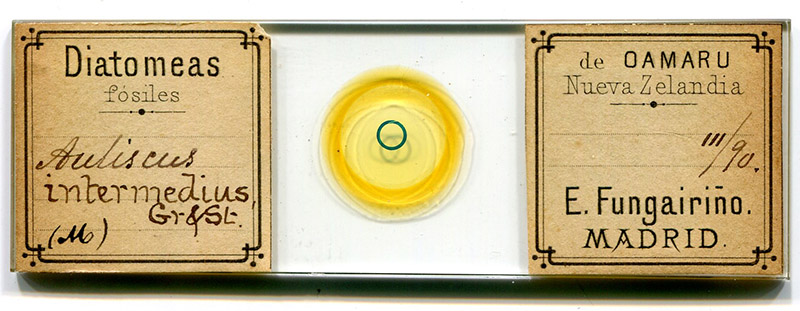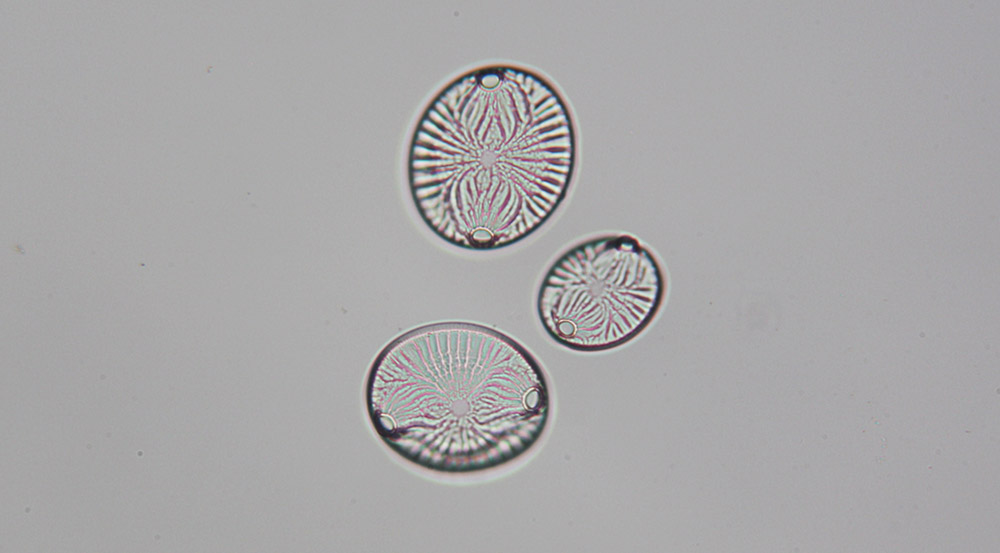
Figure 1. Selected Auliscus intermedius diatoms from the Oamaru deposit, New Zealand, prepared ca. 1900 by Eduardo Fungairiño.
Eduardo Fungairiño de la Peña, 1838 - 1916
by Brian Stevenson
last updated December, 2018
Eduardo Fungairiño was an expert diatomist, well known in his time for authoritative studies of the Oamaru, Morón, and other fossil deposits. He was also an expert mounter of diatoms. After his death, much of his collection went to the Instituto Tecnológico Geominero de España (now Instituto Geológico y Minero de España), in Madrid. However, a small number of his high-quality slides can be found in private collections (Figures 1 and 2).

Figure 1.
Selected Auliscus intermedius diatoms from the Oamaru deposit, New Zealand, prepared ca. 1900 by Eduardo Fungairiño.

Figure 2.
Three Auliscus intermedius diatoms, mounted by Eduardo Fungairiño.
Eduardo Fungairiño was born during 1838 in San Fernando, Cadiz, Andalusia, Spain. He appears to have been the eldest of four children of Juan Demetrio Fungairiño Franco, a Captain of the Navy, and Manuela de la Peña Paredes.
Eduardo became head of the engraving/printing section of the Hydrography Directorate of the Spanish Ministry of the Navy. He earned several awards for his service, including appointment as an honorary Navy Lieutenant.
Ca. 1874, he married Emilia Fernandez-Campa del Rivero. They had five children, a son and then four daughters. The son, also named Eduardo, became a well-known civil engineer.
As a side effect of his career in studying the ocean and other waters, Fungairiño adopted the study of diatoms and mollusk shells (conchology). A biographer wrote, “Enamorado de la naturaleza y atraído por la observación a través del microscopio, se interesó por las diatomeas, elaborando, con gran paciencia y minuciosidad, preparaciones microscópicas claras y de extraordinaria belleza, preparaciones que rotulaba con muy buena caligrafía. Se relacionó con los más cualificados diatomólogos europeos, entre ellos Otto Witt, y ha sido considerado como el indiscutible especialista de las diatomeas fósiles de Oamaru (Nueva Zelanda), el más famoso yacimiento de diatomeas fósiles del mundo.” (In love with nature and attracted by observation through a microscope, he became interested in diatoms, preparing, with great patience and meticulousness, clear microscopic preparations of extraordinary beauty, preparations that he labeled with very good calligraphy. He was associated with the most qualified European diatomists, among them Otto Witt, and has been considered an undisputed expert in fossil diatoms on Oamaru (New Zealand), the most famous fossil diatom deposit in the world.).
Eduardo Fungairiño died on January, 1916, in Madrid, at the age of 78.
Resources
Bracegirdle, Brian (1998) Microscopical Mounts and Mounters, Quekett Microscopical Club, London, pages 44 and 138, Plate 17-M
Eduardo Fungairiño’s family genealogy, accessed through gw.geneanet.org
Enciclopedia Universal Ilustrada EuropeoAamericana (1924) Fungairiño de la Peña (Eduardo), page 216
Gomis Blanco, Alberto (accessed December, 2022) Fungairiño de la Peña, Eduardo, Real Academia de la Historia, http://dbe.rah.es/biografias/9985/eduardo-fungairino-de-la-pena
Pastor, Rafael (1991) La colección de diatomeas del Instituto Tecnológico Geominero de España, Boletín Geológico y Minero, vol. 102, pages 19-92
The Scientists’ International Directory (1894) “Fungairino, Eduardo, Orellana, 5, 3o, Madrid, Diatoms”, S. Cassino, Boston, page 138
The Scientists’ International Directory (1905) “Fungairino, Eduardo, Calle de Orellana 10, JI, Madrid, Diatoms”, S. Cassino, Boston, page 138